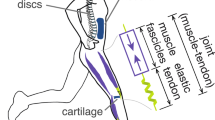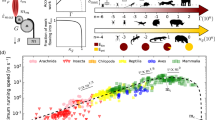Energy bursts from a horse's elastic biceps muscles provide power for a flat-out gallop.
Abstract
Fast runners must be able to protract their limbs quickly in order to prepare for the next stance phase1,2,3. This is particularly challenging for large animals as their limbs are long4 and their muscles contract slowly and have a low power output5,6. Here we show that horses cannot achieve the high power output required for rapid limb protraction by simple muscle contraction and that they instead deploy an elastic biceps muscle to store and then release bursts of energy — this muscle's catapult action has an output that is comparable to over 100 times its mass of non-elastic muscle. Although grasshoppers and fleas are known to rely on a similar catapult mechanism for rapid acceleration7,8, to our knowledge this has not been demonstrated before in larger animals.
This is a preview of subscription content, access via your institution
Access options
Subscribe to this journal
Receive 51 print issues and online access
$199.00 per year
only $3.90 per issue
Buy this article
- Purchase on Springer Link
- Instant access to full article PDF
Prices may be subject to local taxes which are calculated during checkout

DEPT ANATOMY, UNIV. BRISTOL

Similar content being viewed by others
References
Weyand, P. G., Sternlight, D. B., Bellizzi, M. J. & Wright, S. J. Appl. Physiol. 89, 1991–1999 (2000).
Pratt, G. W. & O' Connor, J. T. Am. J. Vet. Res. 39, 249–253 (1978).
Hutchinson, J. R. & Garcia, M. Nature 415, 1018–1021 (2002).
Schmidt-Nielsen, K. Scaling: Why is Animal Size so Important? (Cambridge Univ. Press, Cambridge, 1984).
Woledge, R. C., Curtin, N. A. & Homsher, E. Monogr. Physiol. Soc. 41 (Academic, London, 1985).
Rome, L. C., Sosnicki, A. A. & Goble D. O. J. Physiol. 431, 173–185 (1990).
Alexander, R. McN. Elastic Mechanisms in Animal Movement (Cambridge Univ. Press, Cambridge, 1988).
Bennet Clark, H. C. J. Exp. Biol. 63, 53–83 (1975).
Biewener, A. A. & Roberts, T. J. Ex. Sport Sci. Rev. 28, 99–107 (2000).
Peplowski, M. M. & Marsh, R. L. J. Exp. Biol. 200, 2861–2870 (1997).
Biewener, A. A. Comp. Biochem. Physiol. B 120, 73–87 (1998).
Hermanson, J. W. & Hurley, K. J. Acta Anat. 137, 146–156 (1990).
Dyce, K. M., Sack, W. O. & Wensing, C. J. G. (eds) Textbook of Veterinary Anatomy 2nd edn, 542–575 (Saunders, London, 1987).
Author information
Authors and Affiliations
Corresponding author
Ethics declarations
Competing interests
The authors declare no competing financial interests.
Supplementary information
41586_2003_BF421035a_MOESM1_ESM.zip
Supplementary Animation. If you do not have the Shockwave Plug-in please download it from http://www.macromedia.com/downloads/. (ZIP 52 KB)
Rights and permissions
About this article
Cite this article
Wilson, A., Watson, J. & Lichtwark, G. A catapult action for rapid limb protraction. Nature 421, 35–36 (2003). https://doi.org/10.1038/421035a
Published:
Issue Date:
DOI: https://doi.org/10.1038/421035a
This article is cited by
-
A Conceptual Exploration of Hamstring Muscle–Tendon Functioning during the Late-Swing Phase of Sprinting: The Importance of Evidence-Based Hamstring Training Frameworks
Sports Medicine (2023)
-
Shear-stress sensing by PIEZO1 regulates tendon stiffness in rodents and influences jumping performance in humans
Nature Biomedical Engineering (2021)
-
Remarkable muscles, remarkable locomotion in desert-dwelling wildebeest
Nature (2018)
-
Muscle fascicle shortening behaviour of vastus lateralis during a maximal force–velocity test
European Journal of Applied Physiology (2017)
-
Optimal variable stiffness control: formulation and application to explosive movement tasks
Autonomous Robots (2012)
Comments
By submitting a comment you agree to abide by our Terms and Community Guidelines. If you find something abusive or that does not comply with our terms or guidelines please flag it as inappropriate.



